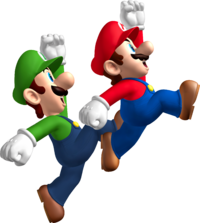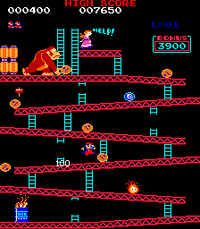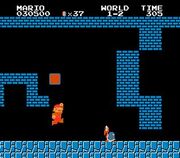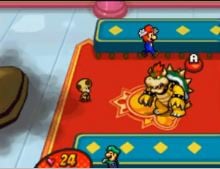Welcome to the new Mariopedia!
Jump
It has been requested that this article be rewritten and expanded to include more information.
- “As you know, the primary action for mobile creatures is the jump, if you follow.”
- —Stuffwell, Mario & Luigi: Partners in Time
Jumping is Mario and Luigi's trademark move. While it has only been used to evade obstacles in the original Donkey Kong game, it has been Mario's primary method of attacking since Super Mario Bros. Depending on the type of the game, Mario and other playable characters jump for very different purposes.
History
Donkey Kong series
Donkey Kong
In the original arcade version of Donkey Kong, Mario (or Jumpman) had to jump over the barrels that Donkey Kong threw at him. He could only jump high enough to leap right over the barrel, in contrast to the impossibly high jumps in the Super Mario Bros. series. If Jumpman landed on a barrel in the game, he would die. In the early concept of Donkey Kong, Jumpman originally wasn't able to jump. It was implemented when Shigeru Miyamoto and his team thought "If you had a barrel rolling towards you, what would you do?".[1]
Donkey Kong (Game Boy)
In Donkey Kong on the Game Boy, Mario has a greater variety of moves related to jumping. If the player jumped, then pressed down on the d-pad, Mario would make a handstand. From the handstand position, Mario could perform high jumps and wide jumps depending on the situation. Unlike all other 2D Mario titles, Donkey Kong would also punish the player for falling too far, resulting in Mario losing a life. This jump system has also been used in Mario vs. Donkey Kong.
Mario Bros.
In Mario Bros., jumping was the primary attack of Mario and Luigi and the only way to defeat enemies. By jumping at the platforms on which the enemies were standing on from below, the player could turn the enemies around. The enemies would then have to be finished off with a kick. Unlike future games, jumping on enemies is still deadly in Mario Bros. Because of this, the Shellcreepers have been changed to Spinies in all remakes of the game to remind players not to jump on them.
Super Mario series
Since Super Mario Bros., jumping has been a much more integral part of the games, and is not just used to jump over gaps and enemies. The game featured all kinds of Brick Blocks in which Mario could find coins, as well as Question Blocks that contained Mushrooms and Fire Flowers. To break those blocks, the player has to jump at their bottom side. Mario could also defeat enemies like Goombas and Hammer Bros. in the game by jumping on them. Koopa Troopas were not defeated by the jump, but they hid in their shells which could then be kicked by the player.
In later games of the series, Mario and other playable characters use a greater variety of jump moves which can be used to reach certain other areas or get bonus items from special blocks. These include the Spin Jump from Super Mario World, the Ground Pound first seen in Super Mario World 2: Yoshi's Island, and even the Double Jump, the Triple Jump and the Wall Jump, introduced in Super Mario 64.
Super Mario Bros. 2
In Super Mario Bros. 2, jumps served a different purpose than in all other games, due to the game using the only slightly altered Yume Kōjō: Doki Doki Panic as its engine. The characters in the game could not defeat any enemies by jumping on them. Instead, they could stand on them and pick them up by using the B button. Players could even jump on Birdo's eggs and throw those at Birdo. Picked-up enemies and items could be thrown to knock out other enemies. This system has been carried over to Donkey Kong on the Game Boy.
Super Mario Sunshine
Mario's jump can defeat most enemies. When using F.L.U.D.D.'s hover nozzle, Mario can float higher and longer. In addition, if Mario loses health, he sounds weaker when he jumps. Also, if Mario jumps over a gap or a void, Mario's jumping sound would sound different.
Mario Kart series
In Super Mario Kart, players could hop with the press of a button. The Feather allowed them to do a high jump. Jumps can be used to cross gaps and to take shortcuts. In later games of the Mario Kart series, jumping is usually only possible when using ramps. In Mario Kart Wii, it was possible to do tricks after jumping off, giving players a small boost.
Super Mario RPG: Legend of the Seven Stars
In Super Mario RPG: Legend of the Seven Stars, the Jump was a special move that requires Flower Points. It does additional damage as a Timed Hit, and its power increases with the Jump Shoes. Mario can use this move from the beginning of the game on. Mario's jump was also used by many characters in the game to verify his identity. Everyone also seems to think of it as his most defining characteristic like when the child in mushroom kingdom thinks he can jump higher then mario.
Paper Mario series
In Paper Mario and Paper Mario: The Thousand-Year Door, jumping is Mario's primary attack he can use from the beginning of the game. It can be used to defeat any kind of generic enemy like the Goombas, but some enemies like the Spiked Goombas would prevent jump attacks with spikes, and the player would have to use the Hammer attacks instead. Jumping is also used on the overworld for platforming elements. In both games, Mario can increase his jump power and abilities with the Super Boots and the Ultra Boots.
Mario & Luigi series
Mario & Luigi: Superstar Saga used the same concept for jumps as the Paper Mario series. On the overworld, Mario and Luigi could also perform the High Jump and the Spin Jump to reach higher areas. Many Bros. Attacks would also use jump moves. In Mario & Luigi: Partners in Time, the piggyback jumps with Baby Mario and Baby Luigi increased the number of jump commands.
List of Jumps
- Co-Star Super Jump
- Stomp
- Double Jump
- Triple Jump
- Floaty Jump
- Flutter Jump
- Long Jump
- Hop
- Super Jump
- Super Jump Punch
- Spring Jump
- Tornado Jump
- Spin Jump
- High Jump
- Fly
- Power Squat Jump
- Somersault
- Somersault (Backflip)
- Wall Jump
- Back Flip
- Side Flip
- Ball Hop
- Cap Jump
Names in other languages
| Language | Name | Meaning |
|---|---|---|
| Japanese | ジャンプ janpu |
Jump |
| Dutch | Springen Sprong |
To jump Jump |
| French | Sauter Saut |
To jump Jump |
| German | Springen Sprung |
To jump Jump |
| Italian | Salto | Jump |
| Korean | 점프 jeompeu |
Jump |
| Portuguese | Saltar Salto |
To jump Jump |
| Russian | Прыжок Pryzhok |
Jump |
| Spanish | Saltar Salto |
To jump Jump |
References
- Jumps
- Donkey Kong moves
- Donkey Kong (game)
- Donkey Kong Jr.
- Donkey Kong 64
- Donkey Kong Country
- Donkey Kong Country 2: Diddy's Kong Quest
- Donkey Kong Country 3: Dixie Kong's Double Trouble!
- Donkey Kong Country Returns
- Donkey Kong Country: Tropical Freeze
- Donkey Kong Land
- Donkey Kong Land 2
- Donkey Kong Land III
- Luigi's Mansion: Dark Moon
- Mario + Rabbids Kingdom Battle
- Mario & Luigi: Bowser's Inside Story moves
- Mario & Luigi: Dream Team moves
- Mario & Luigi: Paper Jam moves
- Mario & Luigi: Partners in Time moves
- Mario & Luigi: Superstar Saga moves
- Mario Bros.
- New Super Luigi U
- New Super Mario Bros. 2
- New Super Mario Bros. U
- New Super Mario Bros. Wii
- New Super Mario Bros.
- Nintendo Land moves
- Paper Mario special moves
- Paper Mario: Color Splash
- Paper Mario: Sticker Star
- Paper Mario: The Thousand-Year Door moves
- Super Mario 3D Land
- Super Mario 3D World
- Super Mario 64
- Super Mario 64 DS
- Super Mario Advance 4: Super Mario Bros. 3
- Super Mario Bros. 2
- Super Mario Bros. 3
- Super Mario Bros.
- Super Mario Bros.: The Lost Levels
- Super Mario Galaxy
- Super Mario Galaxy 2
- Super Mario Land
- Super Mario Land 2: 6 Golden Coins
- Super Mario Maker
- Super Mario Odyssey
- Super Mario RPG: Legend of the Seven Stars moves
- Super Mario Run
- Super Mario Sunshine
- Super Mario World
- Super Mario World 2: Yoshi's Island
- Super Paper Mario moves
- Super Princess Peach
- Super Smash Bros.
- Super Smash Bros. Brawl
- Super Smash Bros. for Nintendo 3DS / Wii U
- Super Smash Bros. Melee
- Super Smash Bros. series moves
- Virtual Boy Wario Land
- Wario moves
- Wario Land: Shake It!
- Wario Land: Super Mario Land 3
- Wario Land 3
- Wario Land 4
- Wario Land II
- Wario World
- Yoshi moves
- Yoshi Touch & Go
- Yoshi's New Island
- Yoshi's Island DS
- Yoshi's Island: Super Mario Advance 3
- Yoshi's Story
- Yoshi's Woolly World



